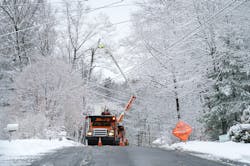Microgrids to the Rescue? NERC Warns Grid Reliability at Risk this Winter
According to the North American Electric Reliability Corporation’s (NERC) most recent Winter Reliability Assessment, a prolonged, wide-area cold snap will put the reliability of the electric grid at risk across nearly all of the areas evaluated.
Mark Olson, manager of reliability assessments for NERC, summarized the organization’s findings during a recent webinar hosted by the American Council on Renewable Energy.
“It’s a much bigger area than we’ve seen in the past,” Olson said. “We found that even though nearly all of the areas we assess have adequate resources for a normal winter peak demand, the risk from a prolonged wide-area cold snap is very challenging.”
Olson explained that NERC conducted its assessment by reviewing peak reserve margins and trends and probabilistic energy metrics, as well as operational risk scenarios designed to determine if the area has sufficient reserves under different demand levels and generator performance conditions.
“Our expanding risk map for this year is really the result of rising peak demand forecasts and the operational challenges that go along with forecasting demand in winter,” Olson said, adding that the “increasingly interconnected nature of the natural gas and bulk power systems” is also driving up the risk.
Grid reliability impacts national security
As Jonathan Monken, principal at Converge Strategies, pointed out during the webinar, the reliability challenges illustrated in NERC’s report have significant implications when it comes to national security.
According to “the most recently available data for fiscal year 2021, there were over 6,000 energy outages at Department of Defense installations across the United States,” Monken said.
“It's a massive number,” he added. “We're talking about more than 3,000 days of lost power across all of the installations. And quite frankly, when we talk about what the potential for mission impact is there, it's significant.”
Microgrids provide energy security
When asked for her thoughts on the NERC report, Jana Gerber, North America microgrids president for Schneider Electric, told Microgrid Knowledge that “microgrids offer a solution to the electric reliability risks outlined in the report by enabling the decentralization of energy.”
She added that distributed energy resources (DERs) such as battery storage and solar panels move energy production closer to the demand center, which increases resilience.
Nicole Bulgarino, executive vice president and general manager of federal solutions for Ameresco, gave Microgrid Knowledge a similar response.
“By diversifying the energy mix and incorporating renewable sources, microgrids contribute to a more robust and adaptable energy infrastructure, reducing the overall risk of supply inadequacy,” Bulgarino said.
Bulgarino noted that because microgrids are inherently flexible, they can respond rapidly to changes in demand.
“In instances where electric heating systems drive up demand during freezing temperatures, microgrids can dynamically adjust their output to meet these surges,” Bulgarino said. “This responsiveness helps mitigate the strain on the broader grid, preventing potential grid instability and ensuring a more reliable electricity supply.”
Microgrids support national security
Both Schneider Electric and Ameresco have been involved in developing microgrid projects for the U.S. military, which is investing heavily in the technology because of the energy resilience it can provide critical infrastructure sites such as military bases.
Last year, the Army announced it would build microgrids at each of its 130 bases worldwide by 2035. Other branches of the military have made similar commitments with microgrids installed or under construction at Marine Corps Air Station Miramar in California, as well as New Mexico’s Kirtland Air Force Base and White Sands Missile Range, among a growing list of other military facilities.
Gerber called microgrids a game changer when it comes to strengthening U.S. military bases against energy disruptions.
“Microgrids not only reduce our reliance on fossil fuels, making our military installations less susceptible to attacks on our energy infrastructure, but they also provide a reliable and secure energy source for our critical operations,” she said.
Bulgarino explained that the deployment of microgrids, both on military bases and at off-base critical infrastructure sites that support the bases, creates a layered approach to resilience.
“Microgrids act as a safeguard against weather-related power outages, ensuring that essential operations remain functional even in the face of broader grid challenges,” she added.
About the Author
Kathy Hitchens
Special Projects Editor
I work as a writer and special projects editor for Microgrid Knowledge. I have over 30 years of writing experience, working with a variety of companies in the renewable energy, electric vehicle and utility sector, as well as those in the entertainment, education, and financial industries. I have a BFA in Media Arts from the University of Arizona and a MBA from the University of Denver.

